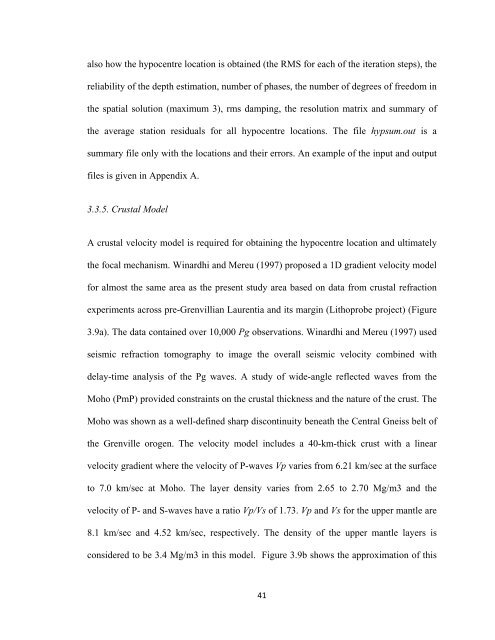western quebec and southern ontario - Department of Geology
western quebec and southern ontario - Department of Geology
western quebec and southern ontario - Department of Geology
Create successful ePaper yourself
Turn your PDF publications into a flip-book with our unique Google optimized e-Paper software.
also how the hypocentre location is obtained (the RMS for each <strong>of</strong> the iteration steps), thereliability <strong>of</strong> the depth estimation, number <strong>of</strong> phases, the number <strong>of</strong> degrees <strong>of</strong> freedom inthe spatial solution (maximum 3), rms damping, the resolution matrix <strong>and</strong> summary <strong>of</strong>the average station residuals for all hypocentre locations. The file hypsum.out is asummary file only with the locations <strong>and</strong> their errors. An example <strong>of</strong> the input <strong>and</strong> outputfiles is given in Appendix A.3.3.5. Crustal ModelA crustal velocity model is required for obtaining the hypocentre location <strong>and</strong> ultimatelythe focal mechanism. Winardhi <strong>and</strong> Mereu (1997) proposed a 1D gradient velocity modelfor almost the same area as the present study area based on data from crustal refractionexperiments across pre-Grenvillian Laurentia <strong>and</strong> its margin (Lithoprobe project) (Figure3.9a). The data contained over 10,000 Pg observations. Winardhi <strong>and</strong> Mereu (1997) usedseismic refraction tomography to image the overall seismic velocity combined withdelay-time analysis <strong>of</strong> the Pg waves. A study <strong>of</strong> wide-angle reflected waves from theMoho (PmP) provided constraints on the crustal thickness <strong>and</strong> the nature <strong>of</strong> the crust. TheMoho was shown as a well-defined sharp discontinuity beneath the Central Gneiss belt <strong>of</strong>the Grenville orogen. The velocity model includes a 40-km-thick crust with a linearvelocity gradient where the velocity <strong>of</strong> P-waves Vp varies from 6.21 km/sec at the surfaceto 7.0 km/sec at Moho. The layer density varies from 2.65 to 2.70 Mg/m3 <strong>and</strong> thevelocity <strong>of</strong> P- <strong>and</strong> S-waves have a ratio Vp/Vs <strong>of</strong> 1.73. Vp <strong>and</strong> Vs for the upper mantle are8.1 km/sec <strong>and</strong> 4.52 km/sec, respectively. The density <strong>of</strong> the upper mantle layers isconsidered to be 3.4 Mg/m3 in this model. Figure 3.9b shows the approximation <strong>of</strong> this41
















